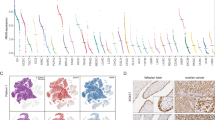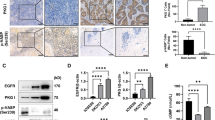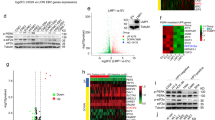Abstract
The adenovirus type 5 gene E1A is known to suppress tumorigenicity by transcriptionally downregulating HER-2/neu (HER2) or by inducing apoptosis. We show here that E1A also suppressed the tumorigenicity of the low-HER2-expressing ovarian cancer cell line OVCAR-3 by decreasing cell proliferation. We further found that the mechanism responsible for this reduced proliferation is the presence of PEA15 (phosphoprotein enriched in astrocytes), which is upregulated by E1A in ovarian cancer; PEA15 promotes translocation of ERK from the nucleus to the cytoplasm, leading to inhibition of ERK-dependent transcription and proliferation. Indeed, siRNA-mediated knockdown of PEA15 expression in OVCAR-3 stable E1A transfectants resulted in a nuclear accumulation of the active form of ERK, followed by an increase in Elk-1 activity, DNA synthesis, and anchorage-independent growth. Finally, PEA15 by itself suppressed colony formation in breast and ovarian cancer cell lines, in which E1A is known to have antitumor activity. We conclude that part of the antitumor effect of E1A in ovarian cancer results from cytoplasmic sequestration of the activated form of ERK by PEA15.
This is a preview of subscription content, access via your institution
Access options
Subscribe to this journal
Receive 50 print issues and online access
$259.00 per year
only $5.18 per issue
Buy this article
- Purchase on Springer Link
- Instant access to full article PDF
Prices may be subject to local taxes which are calculated during checkout





Similar content being viewed by others
References
Araujo H, Danziger N, Cordier J, Glowinski J, Chneiweiss H . (1993). J Biol Chem 268: 5911–5920.
Bera TK, Guzman RC, Miyamoto S, Panda DK, Sasaki M, Hanyu K et al. (1994). Proc Natl Acad Sci USA 91: 9789–9793.
Byrd PJ, Grand RJ, Gallimore PH . (1988). Oncogene 2: 477–484.
Chang JY, Xia W, Shao R, Sorgi F, Hortobagyi GN, Huang L et al. (1997). Oncogene 14: 561–568.
Condorelli G, Trencia A, Vigliotta G, Perfetti A, Goglia U, Cassese A et al. (2002). J Biol Chem 277: 11013–11018.
Condorelli G, Vigliotta G, Cafieri A, Trencia A, Andalo P, Oriente F et al. (1999). Oncogene 18: 4409–4415.
Condorelli G, Vigliotta G, Iavarone C, Caruso M, Tocchetti CG, Andreozzi F et al. (1998). EMBO J 17: 3858–3866.
Danziger N, Yokoyama M, Jay T, Cordier J, Glowinski J, Chneiweiss H . (1995). J Neurochem 64: 1016–1025.
Debbas M, White E . (1993). Genes Dev 7: 546–554.
Deng J, Xia W, Hung MC . (1998). Oncogene 17: 2167–2175.
Douglas JL, Gopalakrishnan S, Quinlan MP . (1991). Oncogene 6: 2093–2103.
Estelles A, Charlton CA, Blau HM . (1999). Dev Biol 216: 16–28.
Estelles A, Yokoyama M, Nothias F, Vincent JD, Glowinski J, Vernier P et al. (1996). J Biol Chem 271: 14800–14806.
Formstecher E, Ramos JW, Fauquet M, Calderwood DA, Hsieh JC, Canton B et al. (2001). Dev Cell 1: 239–250.
Freedman VH, Shin SI . (1974). Cell 3: 355–359.
Frisch SM . (1991). Proc Natl Acad Sci USA 88: 9077–9081.
Frisch SM . (1994). J Cell Biol 127: 1085–1096.
Frisch SM . (2004). Clin Cancer Res 10: 2905–2907.
Frisch SM, Dolter KE . (1995). Cancer Res 55: 5551–5555.
Frisch SM, Mymryk JS . (2002). Nat Rev Mol Cell Biol 3: 441–452.
Frisch SM, Reich R, Collier IE, Genrich LT, Martin G, Goldberg GI . (1990). Oncogene 5: 75–83.
Gaumont-Leclerc MF, Mukhopadhyay UK, Goumard S, Ferbeyre G . (2004). J Biol Chem 279: 46802–46809.
Gum R, Lengyel E, Juarez J, Chen JH, Sato H, Seiki M et al. (1996). J Biol Chem 271: 10672–10680.
Hao C, Beguinot F, Condorelli G, Trencia A, Van Meir EG, Yong VW et al. (2001). Cancer Res 61: 1162–1170.
Hortobagyi GN, Ueno NT, Xia WY, Zhang S, Wolf JK, Putnam JB et al. (2001). J Clin Oncol 19: 3422–3433.
Hwang S, Kuo WL, Cochran JF, Guzman RC, Tsukamoto T, Bandyopadhyay G et al. (1997). Genomics 42: 540–542.
Jemal A, Tiwari RC, Murray T, Ghafoor A, Samuels A, Ward E et al. (2004). CA Cancer J Clin 54: 8–29.
Krueger J, Chou FL, Glading A, Schaefer E, Ginsberg MH . (2005). Mol Biol Cell 8: 3552–3561.
Kubes M, Cordier J, Glowinski J, Girault JA, Chneiweiss H . (1998). J Neurochem 71: 1307–1314.
Land H, Parada LF, Weinberg RA . (1983). Nature 304: 596–602.
Lee WP, Liao Y, Robinson D, Kung HJ, Liu ET, Hung MC . (1999). Mol Cell Biol 19: 8075–8082.
Mymryk JS . (1996). Oncogene 13: 1581–1589.
Nelson CC, Braithwaite AW, Silvestro M, Bellett AJ . (1990). Proc Natl Acad Sci USA 87: 8041–8045.
Pages G, Guerin S, Grall D, Bonino F, Smith A, Anjuere F et al. (1999). Science 286: 1374–1377.
Pages G, Lenormand P, L’Allemain G, Chambard JC, Meloche S, Pouyssegur J . (1993). Proc Natl Acad Sci USA 90: 8319–8323.
Ramos JW, Hughes PE, Renshaw MW, Schwartz MA, Formstecher E, Chneiweiss H et al. (2000). Mol Biol Cell 11: 2863–2872.
Rao L, Debbas M, Sabbatini P, Hockenbery D, Korsmeyer S, White E . (1992). Proc Natl Acad Sci USA 89: 7742–7746.
Renault F, Formstecher E, Callebaut I, Junier MP, Chneiweiss H . (2003). Biochem Pharmacol 66: 1581–1588.
Renganathan H, Vaidyanathan H, Knapinska A, Ramos JW . (2005). Biochem J May 26 (Epub ahead of print].
Ruley HE . (1983). Nature 304: 602–606.
Sebolt-Leopold JS, Dudley DT, Herrera R, Van Becelaere K, Wiland A, Gowan RC et al. (1999). Nat Med 5: 810–816.
Seger YR, Garcia-Cao M, Piccinin S, Cunsolo CL, Doglioni C, Blasco MA et al. (2002). Cancer Cell 2: 401–413.
Shao R, Karunagaran D, Zhou BP, Li K, Lo SS, Deng J et al. (1997). J Biol Chem 272: 32739–32742.
Shao R, Xia W, Hung MC . (2000). Cancer Res 60: 3123–3126.
Teodoro JG, Shore GC, Branton PE . (1995). Oncogene 11: 467–474.
Trencia A, Perfetti A, Cassese A, Vigliotta G, Miele C, Oriente F et al. (2003). Mol Cell Biol 23: 4511–4521.
Ueno NT, Bartholomeusz C, Herrmann JL, Estrov Z, Shao R, Andreeff M et al. (2000). Clin Cancer Res 6: 250–259.
Ueno NT, Yu D, Hung M-C . (1997). Oncogene 15: 953–960.
Whitehurst AW, Robinson FL, Moore MS, Cobb MH . (2004). J Biol Chem 279: 12840–12847.
Xu F, Yu Y, Le XF, Boyer C, Mills GB, Bast Jr RC . (1999). Clin Cancer Res 5: 3653–3660.
Yan DH, Chang LS, Hung MC . (1991). Oncogene 6: 343–345.
Yoo GH, Hung MC, Lopez-Berestein G, LaFollette S, Ensley JF, Carey M et al. (2001). Clin Cancer Res 7: 1237–1245.
Young KS, Weigel R, Hiebert S, Nevins JR . (1989). Mol Cell Biol 9: 3109–3113.
Yu D, Hamada J, Zhang H, Nicolson GL, Hung MC . (1992). Oncogene 7: 2263–2270.
Yu D, Matin A, Xia W, Sorgi F, Huang L, Hung MC . (1995). Oncogene 11: 1383–1388.
Yu D, Suen TC, Yan DH, Chang LS, Hung MC . (1990). Proc Natl Acad Sci USA 87: 4499–4503.
Yu D, Wolf JK, Scanlon M, Price JE, Hung MC . (1993). Cancer Res 53: 891–898.
Yu DH, Scorsone K, Hung MC . (1991). Mol Cell Biol 11: 1745–1750.
Zang RY, Shi DR, Lu HJ, Cai SM, Lu DR, Zhang YJ et al. (2001). Int J Gynecol Cancer 11: 18–23.
Zhang Y, Yu D, Xia W, Hung MC . (1995). Oncogene 10: 1947–1954.
Acknowledgements
We thank Christine Wogan of the Department of Scientific Publications at The University of Texas M. D. Anderson Cancer Center for her expert editorial assistance, Bill Spohn for his assistance with the Zeiss microscope and Wendy Schober of the Flow Cytometry and Cellular Imaging Core Facility at The University of Texas M. D. Anderson Cancer Center. We thank Rita Nahta and Geoffrey Bartholomeusz for critically reading the manuscript. This work was supported in part by National Institutes of Health grants CA76450-1 (to NTU) and CA16672-27 (Cancer Center Support Grant), the Nellie B Connally Breast Cancer Research Fund (to the Breast Cancer Translational Research Laboratory), the National Science Foundation/Ministry of Education, Culture, Sports, Science and Technology of Japan Research Experience Fellowship 2002 (to CB) Blanton-Davis Ovarian Cancer Research Award (to CB and NTU) and CA016672-29 (to the Flow Cytometry and Cellular Imaging Core Facility at The University of Texas M. D. Anderson Cancer Center). This work was in partial fulfillment of the requirements for the PhD degree from The University of Texas Graduate School of Biomedical Sciences at Houston (CB).
Author information
Authors and Affiliations
Corresponding author
Additional information
Supplementary Information accompanies the paper on Oncogene website (http://www.nature.com/onc).
Supplementary information
Rights and permissions
About this article
Cite this article
Bartholomeusz, C., Itamochi, H., Nitta, M. et al. Antitumor effect of E1A in ovarian cancer by cytoplasmic sequestration of activated ERK by PEA15. Oncogene 25, 79–90 (2006). https://doi.org/10.1038/sj.onc.1209014
Received:
Revised:
Accepted:
Published:
Issue Date:
DOI: https://doi.org/10.1038/sj.onc.1209014
Keywords
This article is cited by
-
Cytoplasmic VDR expression as an independent risk factor for ovarian cancer
Histochemistry and Cell Biology (2020)
-
The Anti-Tumor Activity of E1A and its Implications in Cancer Therapy
Archivum Immunologiae et Therapiae Experimentalis (2014)
-
PEA-15 unphosphorylated at both serine 104 and serine 116 inhibits ovarian cancer cell tumorigenicity and progression through blocking β-catenin
Oncogenesis (2012)
-
Adenovirus 5 E1A is responsible for increased expression of insulin receptor substrate 4 in established adenovirus 5-transformed cell lines and interacts with IRS components activating the PI3 kinase/Akt signalling pathway
Oncogene (2009)
-
Pea15
AfCS-Nature Molecule Pages (2008)



